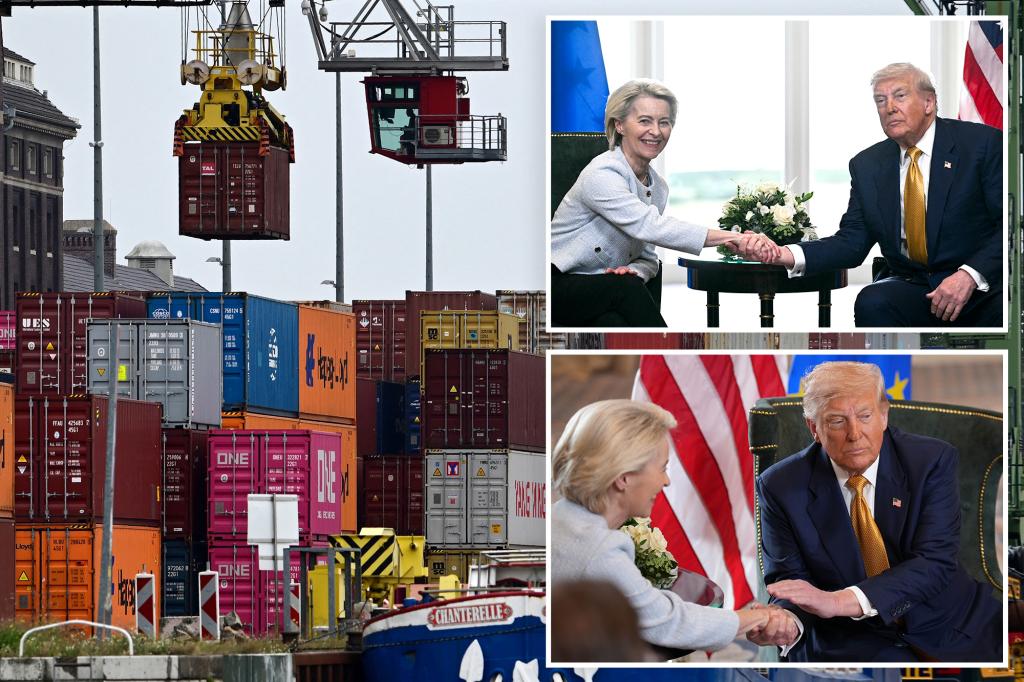It took just 75 minutes for President Trump to get everything he wanted from the European Union.
That’s how long he and European Union Commission President Ursula von der Leyen were away from the cameras.
When they returned, Trump was triumphant. Europe is buy $750 billion in American energy producs, invest $600 billion in new money in the US, buy additional US military equipment and drop all tariffs on American goods, according to the terms of the preliminary agreement.
President Trump announced a new trade deal between the United States and the European Union after a meeting with European Commission President Ursula von der Leyen in Scotland on July 27, 2025. Photo by BRENDAN SMIALOWSKI/AFP via Getty Images
The EU agreed to purchase $750 billion of American energy and invest $600 billion into the US beyond current levels. Getty Images
Tariffs on nearly all European goods coming into the US will be 15%.
The stated terms of the tariff deal appeared to be remarkably lopsided in favor of the US. Neither Trump nor Von der Leyen detailed what major concessions the EU drew from the US other than halving Trump’s threat of a 30% tariff by Friday.
“I think it’s the biggest deal ever made,” Trump proclaimed.
The 27-member bloc is America’s biggest trading partner if taken together, with total trade hitting $1.97 trillion last year. The US trade deficit for goods was $235 billion.
“I think we both wanted to make a deal,” the president said. “It’s going to bring us closer together. I think this deal will bring us very close together.”
Before announcing the agreement, both Trump and Von der Leyen put the odds at making a deal at 50-50. The European leader had flown to Scotland to meet Trump at his Turnberry golf course, where the president spent the morning playing with son Eric.
Trump touted the agreement as the “biggest deal ever made.” AP
“The starting point was an imbalance — a surplus on our side and a deficit on the US side,” the EU boss said when asked about the concessions Trump made. “And we wanted to rebalance the trade relation, and we wanted to do it in a way that trade goes on between the two of us across the Atlantic.”
Part of the arrangement also involved a European agreement to “purchase a vast amount of military equipment” from the US, though Trump noted, “We don’t know what that number is” yet.
Von der Leyen and Trump both shook hands and commended each other on the deal.
European negotiators had sought to score a 10% tariff from the US, mirroring Trump’s baseline rate against foreign countries and the preliminary trade deal he inked with the United Kingdom in May.
Most European goods will face 15% tariffs under the agreement. AFP via Getty Images
One of the goals for Europe was to bring down US tariffs on automobile exports. Trump imposed a 27.5% rate on autos in April. Trump predicted that American auto manufacturers and farmers would be among the happiest constituencies with the deal.
“I think maybe cars would be the one that would go the biggest, and the second would be agriculture, the farmers,” he said.
Before announcing the deal, Trump signaled that “pharmaceuticals won’t be part” of the deal he was planning because his administration is planning a more aggressive approach to reshore manufacturing in that sector. Pharmaceuticals are Europe’s largest export to the US. Trump threatened 200% tariffs on those products last month.
Trump also clarified that his steel and aluminum tariff policy is “staying the way it is,” meaning it would remain at the 50% worldwide rate that Trump announced in June.
Trump emphasized during his gaggle with reporters that he has no intention of delaying the Aug. 1 deadline before his customized “Liberation Day” tariffs take effect. Getty Images
Von der Leyen hailed Trump as a tough negotiator and dealmaker.”
“And fair,” Trump interjected.
Trump emphasized during his gaggle with reporters Sunday that he has no intention of delaying the Aug. 1 deadline before his customized “Liberation Day” tariffs take effect. The president previously moved that deadline twice.
So far, Trump has cut preliminary tariff deals with the UK, Vietnam, Japan, Indonesia and the Philippines. The president teased that his team recently locked down another deal, but didn’t specify which country.
He also has a variety of tariffs in place now, such as a 25% rate on automobiles, aluminum, and steel, as well as 25% on imports from Canada and Mexico that don’t comply with the United States-Mexico-Canada Agreement. He’s also recently mused about jacking up tariffs on Canada and Mexico.
Trump has also reached a tariff truce with China and given Beijing an Aug. 12 deadline to cut a broader deal.
Earlier this month, he gave Moscow an ultimatum to cut a peace deal with neighboring Ukraine within 50 days or else face 100% secondary tariffs on Russian energy — meaning levies imposed on countries that import from Russia.
